Probing the technical difficulties of painting while exploring his own fleeting experiences in life, artist Thomas Reis has produced a wealth of images during his career that are moving, radiant, and timeless.
For much of his career, artist Thomas Reis worked as an illustrator for nationally recognized publications, including Time, Rolling Stone, Sports Illustrated, and many more. Today, Reis finds himself producing magnetic paintings that have earned the artist numerous honors, including his “Amelie” gracing the cover of Fine Art Connoisseur’s December 2012 issue.
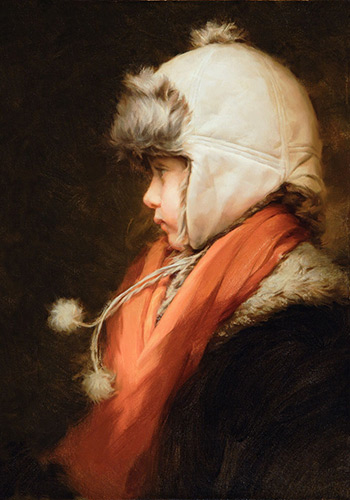
Thomas Reis, “Amelie,” oil, 12 x 19 in. (c) Thomas Reis 2016
Digging to the core of Reis’s creative imagination, one finds a tantalizing story in which the technical challenges of painting and the interests and influences of the artist are given equal significance. “The actual painting process generally progresses the same way each time,” he writes. “I add a quick imprimatura wash to kill the white of the canvas. I then sketch the big masses with vine charcoal — working hard to simplify the shapes, yet maintain accuracy. Next, I use a small filbert with raw umber and medium to repaint and further refine the drawing. Once completed, I often give a light color/medium wash to each major shape, which provides a rough colorized roadmap for the painting. I paint in the darks, which helps me to establish the key of the painting. I work through the middle tones to the lights, redrawing as I go. Once an area has been blocked in, it is often further refined via the addition of transition passages.”
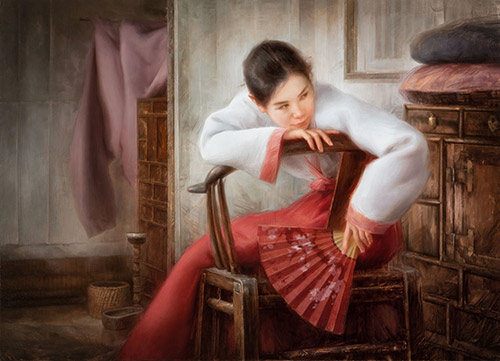
Thomas Reis, “Hanok,” oil, 26 x 36 in. (c) Thomas Reis 2016
The final picture is realized when the artist has exhausted this refinement process and, he writes, “when I run out of ideas as to how to improve it. Color, shape, line, wale, and composition are the primary areas of concern, all of which present endless challenges.”
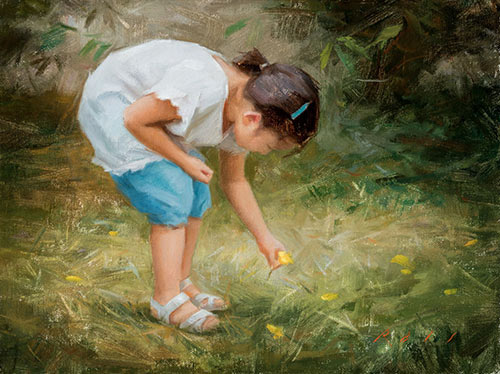
Thomas Reis, “Ina,” oil, 9 x 12 in. (c) Thomas Reis 2016
For Reis, although many of his works have figurative subjects, that isn’t necessarily indicative of a bias. While he acknowledges, “we are social creatures” and “we are interested in people,” the artist’s ultimate results are “regardless of subject, always abstract — massed shapes, values, and color organized on a flat surface.” He says, “To me, that’s what makes figurative, landscapes, and still life subject matter equally valid. What makes those things beautiful, in the end, is the result of individual artistic interpretation. Painting is a summation of the interests and influences of the artist. I believe that this personal interpretation, not the actual subject, is the essence of art.”
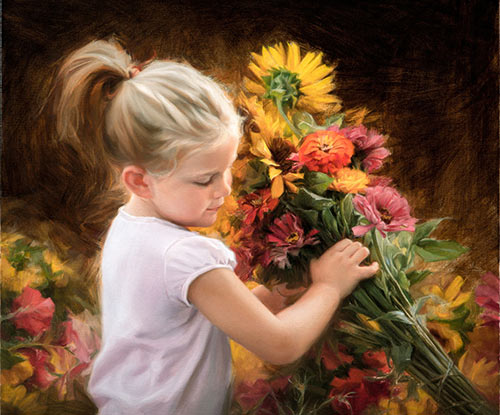
Thomas Reis, “Marietta,” oil, 19 x 22 in. (c) Thomas Reis 2016
For himself, Reis finds complete joy in the creative process. Combine this with his love for “wrestling with all of the technical aspects of painting,” and he is ultimately interested in “conveying the ephemeral nature of experience and a sense of atmosphere and narrative content,” he says. “The fleeting elements in life seem to bring me the most joy. If a sunset were to last all day, I’m sure I’d lose interest in it! I try my best to use all my tools to communicate this sense of the ephemeral.”

Thomas Reis, “Peonies,” oil, 12 x 16 in. (c) Thomas Reis 2016
The future is sure to bring a number of outstanding works from his studio as Reis continues to push himself technically and artistically. He writes, “I hope to grow as an artist. The amazing work of the past and present continue to inspire me and provide a roadmap of the mountains left to climb.”
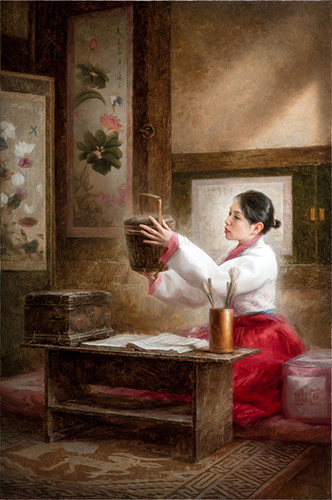
Thomas Reis, “Scribe,” oil, 28 x 42 in. (c) Thomas Reis 2016
Reis is also represented by two galleries: Palm Ave Fine Art in Sarasota, Florida, and Principle Gallery in Charleston, South Carolina.
To learn more, visit Thomas Reis.
This article was featured in Fine Art Today, a weekly e-newsletter from Fine Art Connoisseur magazine. To start receiving Fine Art Today for free, click here.








